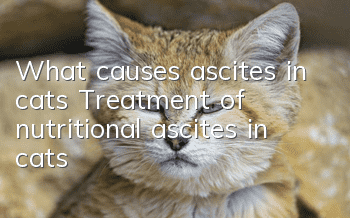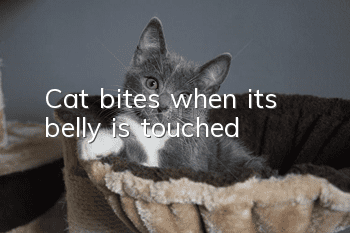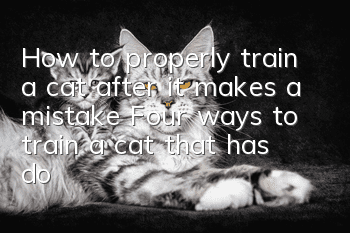What causes ascites in cats? Treatment of nutritional ascites in cats!

What causes ascites in cats? Treatment of nutritional ascites in cats! Pet ascites is a very common clinical disease. Once the disease occurs, it is difficult to cure and has a high fatality rate. There are many causes of this disease, usually including malnutrition, liver and kidney disease, or decreased kidney function. Now I will share with you my recent treatment process for a relatively typical case of nutritional ascites in cats.
1. Basic information of animals
Pear cat, about one year old, male. After consultation, it was found that the cat was originally a stray cat, and the owner brought it back The cat has been kept in the basement for rodent control. It has been fed leftovers for a long time. It has always been thin, but its appetite and energy are still normal. Recently, the cat has found that it is listless, has a decreased appetite, drinks a lot of water, and is unstable in lying and standing. , the abdominal circumference increased significantly, so he was brought to our hospital for treatment.
Figure 1 The sick cat is listless
2. Overall and general examination
1. Overall examination: Observe that the cat is extremely thin , the chest and ribs were clearly visible, the body temperature was 39 degrees Celsius, the abdominal circumference was enlarged and drooped, and there was a strong sense of fluctuation during palpation. Hydroperitoneum was suspected, and the sick cat was short of breath when percussing the abdominal wall.
2. Puncture examination: Use a veterinary puncture needle to puncture the abdominal cavity and drain light yellow clear liquid.
3. Diagnosis
According to the analysis of the cat’s medical history and clinical symptoms, due to its long-term consumption of low protein and single food, and being in the dark Humid and unventilated basements lead to extreme malnutrition and disordered metabolism of the body. Due to the lack of protein in the body, the colloid osmotic pressure in the blood is reduced, renal failure, protein leakage gastroenteritis, and low osmotic pressure, causing a large amount of fluid to enter the abdominal cavity to form ascites. Primary ascites due to malnutrition due to improper feeding management can be identified.
IV. Treatment measures
1. After the cat is placed in a supine position, disinfect the lower abdomen where the tightness of the abdominal cavity is strongest with iodine tincture, and then use 12 # When the needle is inserted 3 to 5 cm into the disinfected area, a light yellow liquid with a slightly fishy smell can be seen flowing out of the abdominal cavity. When 2/3 of the abdominal fluid is released, pull out the needle and press the needle hole with a cotton ball tinctured with iodine. Drainage once a day, 3 to 4 times in a row. The last drainage can drain away the fluid in the abdominal cavity.
2. Replenish fluids and diuresis, and provide appropriate body fluid replenishment according to the clinical symptoms of the cat. Ringer's solution or sugar saline can be infused intravenously, and VC, VB6, ATP, COA, dexamethasone, and antibiotics can be added to the liquid; an appropriate amount of high sugar (10% glucose, mannitol, dextran) and furosemide (furosemide) can be infused intravenously. Diuretic drugs such as furanine and furosemide, once a day.
3. Intravenous infusion of compound 18 or 17 kinds of amino acids, or intravenous infusion of feline albumin, once a day.
4. Feed foods with high protein content, such as eggs, milk, etc.; limit drinking water or exercise; the feeding environment should be dry and ventilated.
5. Treatment effect
After using the above treatment methods for one week, the cat regained its appetite, was in high spirits, and its abdominal circumference was significantly reduced. Basically normal and allowed to be discharged. When discharged from the hospital, the owner was instructed to move the cat to a ventilated and illuminated place, and to increase nutrition in daily feeding, especially protein intake.
6. Experience
1. Furosemide mainly acts on the cortex of the ascending branch of the medullary loop to inhibit the reabsorption of sodium and hydrogen ions, causing sodium and hydrogen ions to A large amount of water remains in the small tube fluid, causing the osmotic pressure in the lumen to increase, causing the corresponding water to remain in the lumen and excreted from the urinary tract, thus showing a significant diuretic effect and preventing large amounts of water from being retained in the tissues and leaking out of the serosal cavity. .
2. Mannitol is a tissue dehydrating agent that can increase plasma osmotic pressure and reduce tissue edema; mannitol has a diuretic effect and is not metabolized in the body. After being filtered by the glomerulus, very little remains in the renal tubules. It is reabsorbed and acts as an osmotic diuretic in renal failure. The dosage of mannitol should be moderate and the dosage should be slow. High concentrations and large doses should be avoided.
3. Dexamethasone has anti-inflammatory, anti-toxic, anti-allergic, and detoxifying effects; antibiotics have antibacterial, anti-inflammatory, and improved kidney function effects.
4. Compound amino acids and feline albumin can supplement a large amount of protein missing in the body. Compound amino acids increase the colloid osmotic pressure; dextran and albumin are colloid osmotic pressure maintainers, and VB6 participates in the amino acid metabolism.
5. When draining and decompressing, be sure not to withdraw too much fluid at one time and too thoroughly, otherwise it may easily lead to intestinal adhesions. Drainage should not be too fast, because when peritoneal effusion occurs, the blood in the blood vessels of the liver, stomach, intestines, and other abdominal organs will be squeezed into the blood vessels outside the chest and abdominal cavity, causing damage to the lungs, stomach, intestines, and chest and abdominal organs. Anemia, if the fluid is discharged too quickly, can cause a large amount of blood to quickly flow into the thoracic and abdominal organs, causing strong dilation and congestion of small arteries and capillaries (called post-anemic congestion), which can easily lead to cerebral anemia and serious consequences. Natural drainage is appropriate, but if it takes a long time, drainage can be done while infusion.
6. Although feline nutritional ascites is difficult to cure and has a high mortality rate, the emphasis is on prevention. In the daily process of raising pets, we should not only make sure that the pets are well fed, but also pay attention to nutritional matching. Even if they are not famous dogs, we should also pay attention to the daily protein of the diet not to be too low, and ensure that the animals have good space for activities and sufficient of light.
- What is the personality of an Abyssinian cat?
- Cat eyebrows are symmetrically bald on both sides
- How to train a cat not to go to bed? How to train a cat not to go to bed!
- How to scientifically raise cats during pregnancy? Will a pregnant woman get infected if she is scratched by a cat?
- How to treat feline seborrheic dermatitis?
- Symptoms and prevention of pica in cats, a must-read for cat owners!
- 6 Signs Your Cat Needs “Deworming”
- Can cats eat broccoli?
- How to easily distinguish male cats from female cats?
- What is the function of cat grass? The functions and uses of cat grass!



